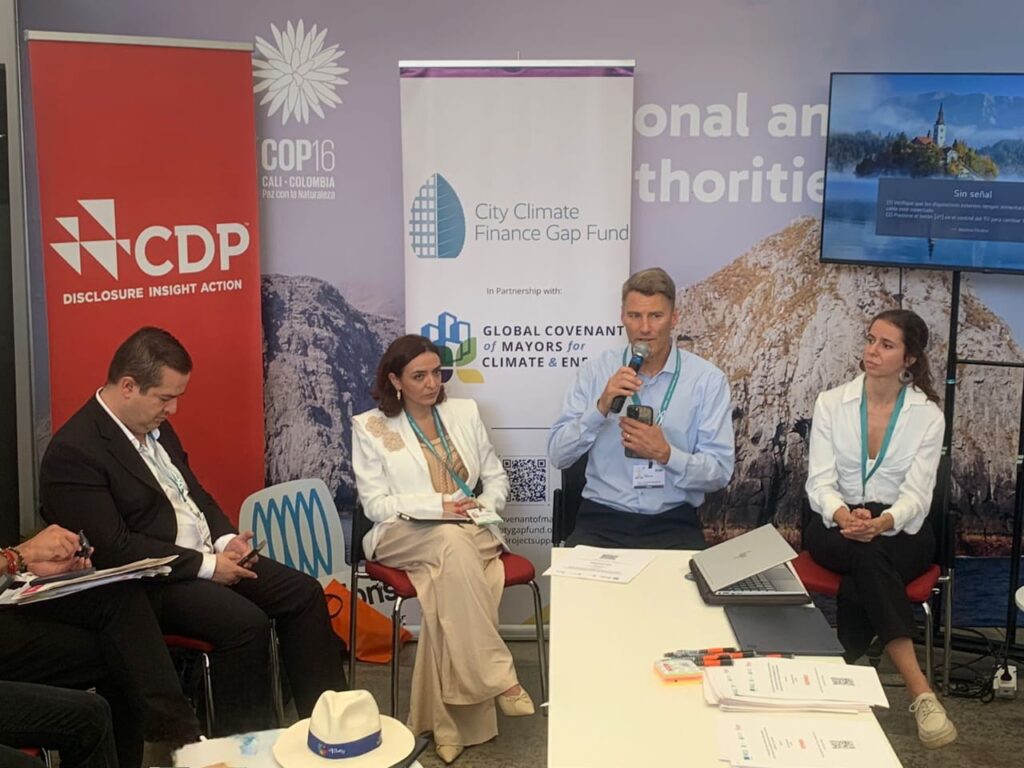
Scaling Urban Nature-Based Solutions Through Green Finance: Key Insights from the GCoM-Gap Fund Partnership at COP16
At the recent COP16 on Biodiversity in Cali, Colombia, key takeaways emerged from the side-event, “Green Financing for Subnational Governments: Expanding Urban Solutions for Nature-Based Solutions (NbS),” held on October 25th. This session underscored how the identification of co-benefits and investment risks, authorities’ leadership, and stakeholders’ engagement are crucial for driving urban solutions that leverage nature to address climate and biodiversity challenges.
Organized by CDP Latam, GCoM Americas, and the GCoM-Gap Fund Partnership, the event brought together several experts to explore Nature-Based Solutions (NbS) strategies and priorities tailored for Latin America. During the opening, Gregor Robertson, GCoM Global Ambassador, along with Reissa Saré of Global CDP and Belén Jiménez of GCoM Americas, highlighted the urgent need to expand local financing for NbS, coordinate biodiversity and climate agendas, and leverage initiatives like the Coalition for High Ambition Multilevel Partnerships (CHAMP) to strengthen climate action in cities.
The event also featured a panel of experts from the World Bank, United National Environmental Programme (UNEP) and ICLEI SAMS, where valuable recommendations were drawn. Xueman Wang, Program Manager of the Global Platform for Sustainable Cities of the World Bank, stressed the relevance of national and local coordination for maximizing NbS benefits as well as piloting investments to assess risks and impacts. Alejandro Gonzalez, Director of ICLEI Colombia, highlighted the need for community involvement for strong contextualization, as well as project ownership and leadership by authorities. In turn, Sharon Gil, Cities Lead of UNEP, added that “currently more roads are being built than forests”, a critical scenario that proves the importance of involving the authorities in the dialogue around NbS projects, as well as the need to think in a sustainable way for identifying opportunities to connect the different benefits delivered by NbS within the urban area.
Subsequently, the event gave way to the practical work block with the presentation of two cases of subnational governments and the subsequent applied analysis of the recommendations provided by the experts. First, Carlos Mario Gutiérrez Arrubla, Mayor of the Municipality of La Estrella (Colombia), presented the initiative of urban green infrastructure around mini-meadows and orchards for the development of a sustainable urban landscape. Then, Jota Lloret Valdivieso, Prefect of the Province of Azuay (Ecuador), presented the progress of the initiative for the ecological and participatory restoration of wetlands in the province. In both cases, the leadership and commitment of the authorities to promote the NbS were highlighted, as well as the challenges regarding the regulatory restrictions that both governments have for the implementation of the NbS and the limitations to access national and international financing.
These NbS ideas and recommendations are intended to guide Latin America’s priorities for action in the run-up to the relevant 2025 climate agenda. The GCOM-Gap Fund Partnership team will follow these recommendations working with partners to support cities in developing climate-resilient project ideas.